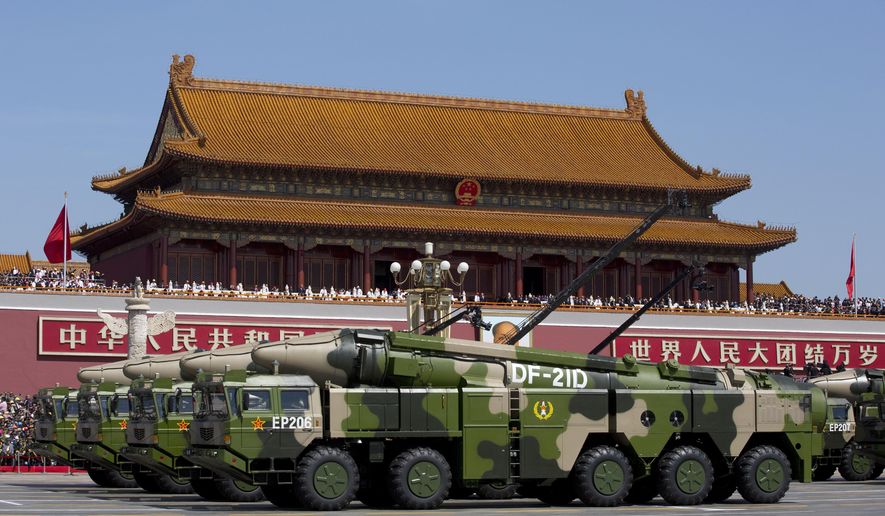China’s recent test of reported new missiles appears to have been a simulated attack on a Taiwanese airfield and a possible test launch of a new hypersonic weapon, according to a U.S. Air Force research center analysis.
The missiles were launched Aug. 13 from a training site in Jilantai in western China and traveled 870 miles west before hitting two targets in an airfield.
“This missile launch event almost certainly featured a new system of some kind and indicates that the [People’s Liberation Army Rocket Force] has modernized yet another missile brigade with a Taiwan-centric mission set,” states an open-source analysis by the China Aerospace Studies Institute, a think tank at the Air Force’s Air University in Alabama.
The report concludes that China’s official accounts of the missile tests were intended for deterrence and amounted to little more than an “overblown show put on by the PLA.” Beijing has stepped up its intimidation campaign against the island democracy in recent months. Officials say Taiwan is an integral part of China and must eventually be reunited with the mainland.
Chinese state media described the missile tests as the firings of two “new-type missiles.” Reporting on the tests triggered a large trending response on Chinese social media. The Chinese reports identified the two missiles as short-range DF-15s from the 613 Brigade that are deployed within range of Taiwan in the hundreds.
However, the Pentagon lists the range for the DF-15 as 500 miles, suggesting either an extended-range version of the missile or a possible hypersonic missile test disguised as a short-range test.
The report said the longer-range flight means the missiles are unlikely to be standard short-range weapons currently in the Chinese rocket forces’ inventory.
The range difference between DF-15 and the 870-mile flight could indicate that the Chinese military has equipped its former DF-15 force with longer-range DF-21 or DF-26 missiles, or CJ-10 cruise missiles. Alternatively, the tests could reveal that the 613 Brigade is now armed with DF-17 hypersonic missiles. These missiles are designed to evade advanced missile defenses by traveling more than five times the speed of sound.
“Previous assessed DF-17 test launches have demonstrated a range of at least [870 miles], which is commensurate with the assessed flight path” of the Aug. 13 launch, the Air Force report said. “These systems are also relatively new to the [Chinese rocket force] and would fit the definition of a ‘new-type missile.’”
A third option is that the two missiles are an entirely new class not observed before. However, China’s military in the past has not deployed new missiles into its forces in that way.
China also may have extended the range of the DF-15 to around 870 miles. The report said that is unlikely unless the missiles contained a “glide vehicle” like that used on the DF-17 hypersonic missile.
The report said additional data is needed to determine which new missile was tested.
“The implication remains that 613 Brigade may now field a missile system that has a substantially longer range than the DF-15s with which it is currently equipped,” the report said.
Chinese state media also said the missile features a new warhead that is hardened against jamming and thus can attack defended information systems. China’s military defines jamming broadly; thus, the new warheads could include electro-optical, infrared or radar-based guidance capable of defeating jammers.
Military writings by officials linked to the 613 Brigade have said some warheads the unit uses are radar-guided.
Commercial satellite images showed that the missile tests did not demonstrate improved warhead accuracy or increased explosive power.
According to the U.S. analysis, China’s military frequently uses advanced weapons tests and military exercises to deter or coerce adversaries.
“With each deterrent activity, the PLA emphasizes the need for there to be some real capability behind the activity, demonstrated resolve, and for the information on the activity to be transmitted to the adversary’s population,” said the report, noting that state-run media report in both Chinese and English. “In this instance, there is some limited capability behind the activity, in that the weapon system in question is real and marginally improves the [rocket force’s] overall capabilities.”
China tested the missiles while stepping up provocations against Taiwan. Near-daily incursions of Taiwanese airspace have included flights of nuclear-capable bombers.
The Jilantai missile training site is also the location of China’s large-scale expansion of nuclear missile forces, where several hundred silos for DF-41 long-range missiles are being built. It is one of three new missile fields for as many as 350 new DF-41s.
Rick Fisher, a China military affairs expert, said the analysis by the China Aerospace Studies Institute indicates that China has an extended-range version of DF-15 or is getting ready for a short-range missile to replace it.
“The DF-15B arsenal, introduced about 2007, could be ending its service life, causing the PLA to exercise with them more and to find ways to exploit them for propaganda impact,” said Mr. Fisher, now an analyst with the International Assessment and Strategy Center.
“This may also indicate a replacement missile is on the way,” he said. “Both the China Aerospace Science and Technology Corp. and the China Aerospace Science and Industry Corp. have developed modular second-generation [short-range ballistic missiles] that could vastly increase the number of missiles aimed at Taiwan.”
China has over 1,200 DF-15s and DF-16 short-range missiles deployed within range of Taiwan, whose main island is just 100 miles off the Chinese coastline.
• Bill Gertz can be reached at bgertz@washingtontimes.com.




Please read our comment policy before commenting.